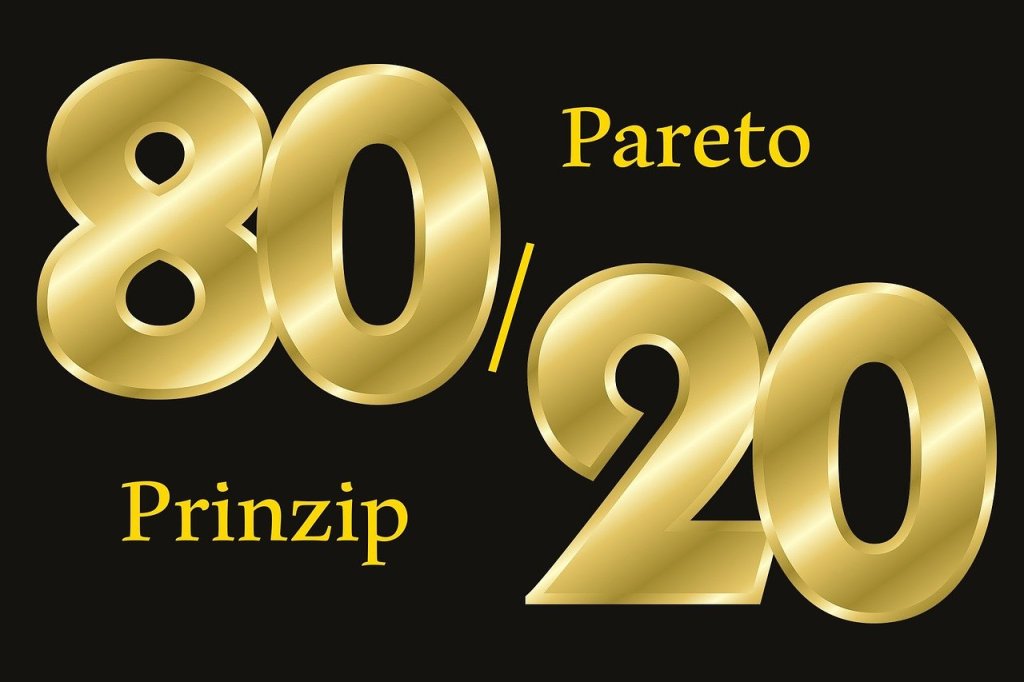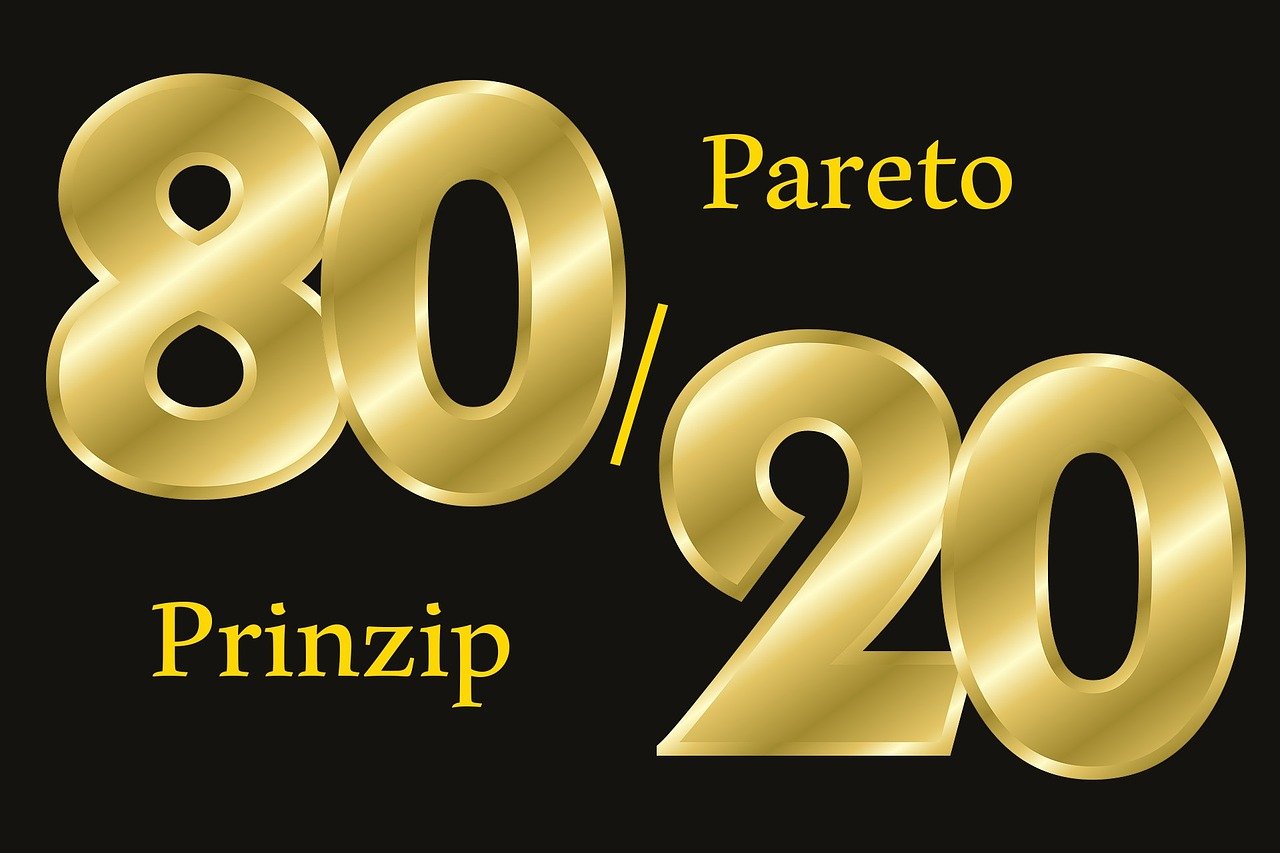Listen on Spotify.
The Pareto Principle – more commonly called the 80 20 rule — was devised by Italian economist Vilfredo Pareto. He found that, in 1896, around 80% of the land in Italy was owned by about 20% of the population, and thereby realised that the minority of the population controlled most of the country’s wealth. He also discovered that 80% of the yield from his pea garden came from 20% of the pea plants.
In the 1940s, Dr. Joseph Juran applied what Pareto discovered to his field of operations management. By this means, he helped organisations increase production by pointing out that around 80% of the problems with the product were caused by only one-fifth of the methods and materials used. Thus, the idea that 80% of results are driven by 20% of activity took root, as did the idea that focusing on improving a few crucial things and ignoring many trivial things can do wonders for productivity. He coined the term the Pareto Principle.
We can use this principle to set ourselves up for success in any area of life, from personal development to helping us achieve success at work and improving our productivity. In the rest of this piece, we will discover how the principle works, why we should use it, and how to apply it in different circumstances.
Let’s dive in and find out more.
How Does the Pareto Principle Work?
Using the Pareto Principle can help us decide where to direct our focus and resources to achieve the best possible outcome. It helps us waste less money, time, and energy and put our best efforts into the most important things. We can cut out the trivial things using this rule and concentrate on the vital 20% so that we can achieve good results in less time.
This rule can also help us understand why so many of us are busy all the time but end up accomplishing little. Most of the time, it happens because we work on multiple low-value tasks and put aside the few things we could be doing that would make a real difference.
One reason for this is that high-value tasks usually require more effort from us and are more challenging, but according to Pareto’s analysis, they are often also the most rewarding.
So, before starting work, we should consider if the task we’re working on is in the top 20% of what we need to do, or whether it falls into the bottom 80%. We should try to resist the temptation to devote all our attention to the least important activities in our day because we will end up neglecting the crucial top 20% of tasks.
If we become accustomed to taking on high-value tasks in the morning when we are fresh, full of energy, and can focus for a relatively long time, we will soon form a habit. When we can do the most complex, most rewarding tasks first thing as a matter of routine, we will undoubtedly see a significant uptick in our productivity.
Soon, we’ll use some examples to illustrate how the 80 20 rule works in practice. Next, though, we’ll talk about reasons to use the Pareto Principle.

Why Use the 80 20 Rule?
The 80 20 rule can help us zero in on activities that will yield the best results and pinpoint the primary causes of problems we face that may be hampering our progress.
Using this principle can also:
- Help us become more effective leaders by knowing where to focus the greater portion of our time and energy.
- Improve our productivity.
- Boost our confidence.
- Teach us how to use the resources at our disposal more efficiently.
- Enable us to set more realistic, achievable goals.
- Help us improve our time management.
- Encourage us to make better decisions.
- Hone our problem-solving skills.
It’s time to look at some real-world examples to see how best to employ this principle in various situations.
Applying the Pareto Principle: Examples
Here, we’ll explore different scenarios in which using the 80 20 rule can be effective.
The 80 20 rule and time management
If we go along with the Pareto Principle, we must acknowledge that being busy does not always mean we are being productive. Those of us who are self-employed or run a small business often feel we must work more hours so we can make enough money to justify not working for someone else.
This can have a hugely detrimental effect on our work-life balance and can lead to increased stress, lower productivity, and even burnout and depression. We could even end up giving up on things that used to be important to us.
Luckily, using the Pareto Principle can help us avoid setting off this downward spiral by identifying tasks that bring in the most revenue, and which will have the best payoff in future. By focusing on these tasks over others, we can get the important things done and leave ourselves more time to relax, have fun, exercise, and spend time with friends and family.
Using the 80 20 rule when setting goals
It can be a smart move to use the 80 20 rule when coming up with goals. Here’s how to do it.
- Write 10 goals on a piece of paper.
- Ask yourself which of those goals you would most like to meet today, and which would have the biggest impact on your life or work. Highlight it.
- Next, choose the second most important goal on your list.
When you’ve done that, you will have pinpointed the most crucial 20% of your goals that are sure to have a greater impact on your life than the others. Focus on them and you will be working more effectively, as well as more efficiently.
Using the Pareto Principle to create a thriving, productive workplace
You can apply the Pareto Principle to discover who the most productive people are and place them in prominent positions so that others can learn from them and become more productive and successful themselves.
Identifying techniques they use to help them be so efficient, and trying to develop the skills they have acquired will help you train other employees at the same time as learning how to be more productive yourself. Over time, both individual and team productivity will improve.
The Pareto Principle and problem-solving
The ability to solve problems is an essential skill in life and work, and we can all get better at solving them if we follow these steps when applying the 80 20 rule.
- Make a list of problems we face in a particular situation, for example, when at work.
- Identify the root cause of each problem.
- Rank each problem in order of importance by giving it a score. We can solve the ones with the highest scores (the top 20%) first.
- Group the problems according to their root cause. All problems caused by the same factor or factors should be grouped together.
- Add up the scores of the problems in each group. The group with the highest score contains the problems to focus on first. We now have a clear idea of where to direct our attention.
- Finally, begin coming up with viable solutions and act.
Now we know how to use it in several situations, let’s explore how this rule can help us boost our productivity.
The Pareto Principle and Productivity
The best way to use this idea to improve productivity is to be crystal clear about what you want to accomplish. Without being clear on that, we are liable to get sucked into working on many things that won’t benefit us much and will not have much of an impact on our lives or happiness.
So, to be as productive as possible, we must take note of all the tasks we will need to do to complete a specific project and flag up the tasks that will help us make the most progress and get us closest to completing the project. By focusing on the most vital 20% of tasks, we will be four-fifths of the way to our goal.
We must make sure we review how we spend our time so that we can ensure we spend more time doing, and less time thinking and planning. While planning and coming up with ideas is important, if we spend 80% of our time planning, we will never achieve all we wish to. To get results, we should switch that ratio around and spend 20% of our time planning and 80% of our time doing.
Wrapping Up
Using the Pareto Principle will help us focus on the things that matter and get the maximum yield for the effort we put in, and will help us make the best use of our time.
To get the most out of the 80 20 rule, you should:
- Have a clear idea of the outcomes you want to achieve.
- Pinpoint the top 20% of activities that will help you reach your goals.
- Work out what you can do each day to progress toward your desired outcome.
- Spend less time thinking and more time doing.
- Review your activity each week to identify which things have the largest positive impact on your goals. Prioritise those things in the following weeks so you can reach your goal sooner.
All that’s left is to apply the Pareto Principle to your own life and see how it benefits you. If you’ve used the 80 20 rule to improve your productivity before, feel free to share your story in the comments!


3 thoughts on “How to Use the Pareto Principle to Boost Productivity”